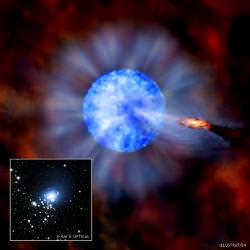Black holes come in two varieties: supermassive and stellar. The supermassive variety can have millions of times
the mass of a star, while the stellar varieties are usually just a few times the mass of a single sun. Using the Chandra X-Ray Observatory, astronomers have turned up the most massive stellar mass black hole ever seen, weighing in at 15.7 times the mass of the Sun, lurking in a nearby galaxy.
M33 is a relatively nearby galaxy, located only 3 million light years from Earth. This newly discovered black hole has been designated as M33 X-7.
Astronomers using NASA’s Chandra X-Ray Observatory and the Gemini telescope on Mauna Kea were able to precisely determine the black hole’s mass because it’s actually in a binary system. Its binary partner is unusual too; a star with 70 times the mass of the Sun.
M33 X-7 orbits its companion star every 3.5 days, briefly passing behind it. This blocks the torrent of X-rays streaming from the environment around the black hole, so that astronomers were able to calculate its orbit. Once they could calculate the orbits of the two binary objects, it’s relatively straightforward to calculate their respective masses.
The fate of the companion star will eventually match its partner. “This is a huge star that is partnered with a huge black hole,” said coauthor Jeffrey McClintock of the Harvard-Smithsonian Center for Astrophysics in Cambridge, Mass. “Eventually, the companion will also go supernova and then we’ll have a pair of black holes.”
Although the black hole has less mass today, it must have started out with more. With more mass in the original star, it would have consumed its fuel more quickly, and detonated as a supernova earlier.
Here’s a puzzle, though. Before the black hole formed, the two stars wouldn’t have been able to orbit so closely. In fact, they would have been orbiting inside each other. This means that they were once further apart, and the process of sharing their outer atmospheres brought their orbits closer together.
Original Source: Chandra News Release

